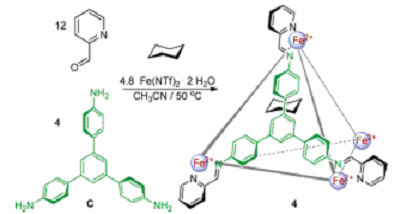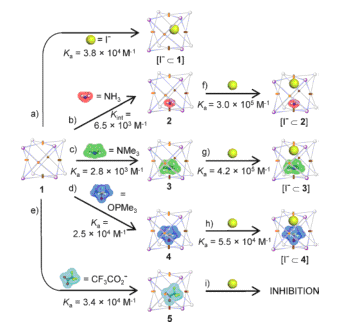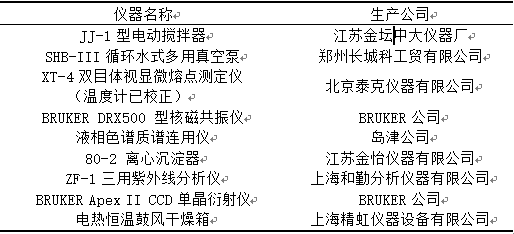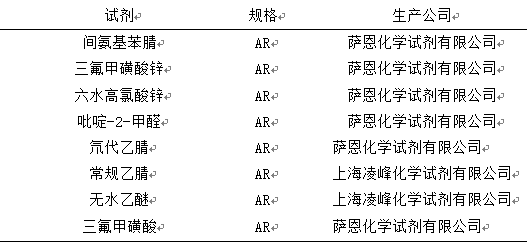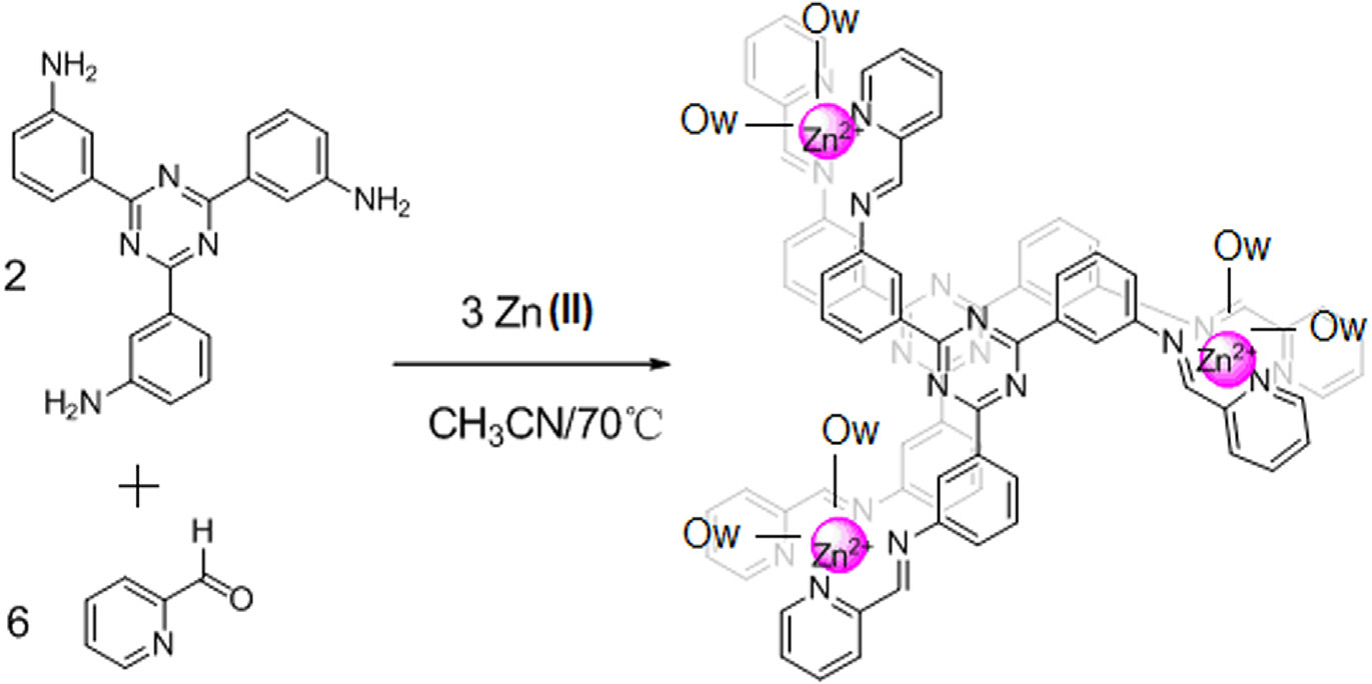间位均三嗪多苯胺前体的超分子配合物自组装毕业论文
2020-07-08 21:39:53
摘 要
超分子配位化学的目的是以研究存在着超分子相互作用的配位化学,超分子的配位键对超分子体系的形成和功能有至关重要的作用。超分子配合产物,也叫做金属有机笼(metal-organic cages, MOCs),是指具有其特定的外观结构、一定的尺寸或空间立体的分立、寡聚配合物(例如配位多边形和多面体、螺旋体、轮烷、索烃等)。超分子配位化学的发展很大程度上依赖于配位超分子自组装的方法和合成方法,而每一种可设计、可预知、可控制的精准巧妙的配位自组装方式的想法,不但将超分子化学推向了前所未有的水平,同时还极大的丰富和提高了现代超分子化学合成方法与技术。本文主要介绍了一种基于间位均三嗪多苯胺前体的超分子配合物的自组装,并运用核磁、质谱和单晶衍射等技术对其结构和主客体作用的性质进行了研究。
以三间氨基苯基均三嗪、Zn(OTf)2 或 Zn (ClO4)2、吡啶-2-甲醛以2:3:6的物质量之比在乙腈溶液中自组装合成了超分子配合化合物Zn3L2,通过元素分析和核磁、质谱技术表征了其化学组成,培养了配合物单晶并进行了晶体结构分析。单晶X射线结构表明该配合物是一种三角双螺旋体,位于三角形顶点的Zn-Zn距离在11.45 Å到13.54 Å 范围内,两个内部的三嗪环之间的距离为3.58 Å。通过加入客体后,Zn3L2三角双螺旋体上H的核磁共振信号发生的位移变化,研究了配合物与不同客体之间的主-客体作用关系,发现主体与四苯硼钠(NaBPh4)的作用最为显著,通过连续滴定实验探索了主客体结合模式与结合常数,推测客体通过构型匹配作用在主体配合物边缘相对开放的“窗口”区域。
关键词:超分子配位化学 间位均三嗪多胺前体 自组装 金属有机笼 主客体化学
Abstract
The aim of supramolecular coordination is to study the coordination chemistry of supramolecular fingertips. The coordination bonds of supramolecular coordination play an important role in the formation and function of supramolecular systems. The supramolecular coordination products, as well as metal-organic cages (MOCs), refer to the discrete and oligomeric complexes (such as the coordination polygon and polyhedron, helix, alkane, hydrocarbon, etc.) with its specific appearance structure, certain size or space. The development of supramolecular coordination chemistry is largely dependent on the methods and synthetic methods of coordination supramolecular self-assembly, and the idea of each design, predictable and controllable precise and ingenious self assembly method not only puts supramolecular chemistry to an unprecedented level, but also greatly enriches and extracts. High modern supramolecular chemical synthesis methods and technologies. In this paper, the self assembly of a supramolecular complex based on the precursors of interposition three azotriazine poly (aniline) is introduced, and the properties of its structure and host and guest are studied by means of NMR, MS and single crystal diffraction.
The supramolecular compound Zn3L2 was synthesized by self assembly of three amino phenyl three azine, Zn (OTf) 2 or Zn (ClO4) 2, and pyridine -2- formaldehyde in acetonitrile solution. The chemical composition of the compound was characterized by elemental analysis and NMR and MS. The crystal structure of the compound was cultured and the crystal structure was analyzed. The structure of single crystal X ray shows that the complex is a trigonometric double helix, and the distance of Zn-Zn at the vertex of the triangle is within the range of 11.45 to 13.54, and the distance between the two internal three azine rings is 3.58, and the entry of the guest molecules can not be accommodated again. After adding the object, the displacement of the magnetic resonance signal of H on the Zn3L2 trigonometric double helix is changed, and the relationship between the main and guest interaction between the complex and the different objects is studied. It is found that the role of the main body and the four sodium benzonate (NaBPh4) is the most significant. The binding mode and the binding constant of the host and the guests are explored through the continuous titration experiment. The object is measured through the "window" area which is relatively open at the edge of the host complex through configuration matching.
KEY WORDS: supramolecular coordination chemistry; three azine polyamine precursor; self assembly; metal-organic cages; host and guest chemistry
目录
第一章 文献综述 1
1.1 引言 1
1.2 研究内容和方法 1
1.3 基于C3对称性的间位均三嗪前体 2
1.4.其他典型的超分子金属配合物 4
第二章 Zn3L2螺旋体1的自组装和结构 9
2.1 实验仪器与试剂 9
2.2三角双螺旋体1的合成 10
2.3实验结果与讨论 10
第三章 Zn3L2螺旋体1的主客体研究 14
3.1客体研究实验方法 14
3-2主-客体研究结果与讨论 14
3.3小结 18
第四章 结论与展望 19
4.1 结论 19
4.2 展望 19
参考文献 21
第一章 文献综述
1.1 引言
1980年,法国科学家J.M.Lehn(莱恩)提出了超分子化学(Superamolecular chemistry)的概念[1]。超分子化学的意义是“超越分子概念的化学”其主要是通过研究两种或者两种以上的,并且具有自组装能力的化学物质,在经过分子之间相对较弱的相互作用而合成的一些比较繁琐和有秩序,并且有着自己的独特功能体系的化学概念,超分子化学属于分子化学的延伸,其经历了从简单到复杂的必然过程。在通过研究每一个分子通过亲水/疏水、静电吸引、 氢键、配位键等分子间作用而形成具有特定功能的体系。分子间的作用所形成的超分子组装物质,因而能够让人们知道作用的最小基本单元不是分子而是超分子,作用产生于超分子组装体之内。超分子结构是化学史上的一次重大飞跃。目前超分子体系成为国内外大部分化学等方面的科学家的重点研究对象,并且将其应用在生命科学[2]、材料科学[3]、环境科学[4]、信息科学等领域。
1.2 研究内容和方法
主要通过选择对称性比较高的多苯胺前体,在乙腈溶液中,以通过过渡金属离子的模板作用,与2-甲醛吡啶为代表的醛类发生自组装作用,定量高效地形成亚胺类配体的金属配合物。经过该类前体所合成的超分子配合物,是具有对称性极高,配位能力极强,配位的形式丰富等特点,通过选择配位数不一样的金属离子和改变其配合前体/金属离子/醛类的配比,能够生成有笼狀/层状/螺旋等结构在内的丰富种类配合物,进而可以根据其结构特点,对其主客体化学/分子磁性/荧光载体等性质进行研究,在分子识别、分子筛选、分子催化、光化学反应、分子传输等领域具有重大应用潜力,是分子材料和超分子化学的前沿热点课题。
化学自组装已经被用来创建具有越来越复杂的几何形状的结构[5],在复杂的三维结构的创建过程中,这些组件之间的联系的动态性质构建模块打开了将这些结构作为自分类多组分系统的一部分的可能性[6],或者探索与适应化学或物理刺激有关的功能[7]。 亚组分自组装方法[8]通过同时形成金属 - 配体配位和动态共价亚胺键来构建复杂的结构[9],使得能够建立稳健的结构,但能够进行动态交换,涉及两者种类不稳定的键型[10]。这种技术提供了一系列离散的金属有机配合物[11],可以通过利用焓和熵驱动力来重新排列[12]。
1.3 基于C3对称性的间位均三嗪前体
在此我们描述了一种基于C3对称配体的Zn(II)配合物,形成独特的三角形三重螺旋结构。这种结构在添加子组分时能够转变成双螺旋结构,其选择性地包封平面芳香性的化学物质。
1.3.1 三角形三螺旋体1的合成和结构
亚组分A(3当量),4-甲氧基苯胺(B,9当量)和三氟甲磺酸锌(II)(3当量)的反应导致选择性形成三角形三联螺旋1(图1-1)。1的核磁共振谱图是复杂的,在芳香区域有30个信号,在脂肪区域有3个信号, 这种拥挤的频谱反映了组件中三个配体的非对称排列,因为对称配置总共只显示11个信号。 二维核磁共振光谱允许峰的分配到三个不同的配体环境。 扩散有序1 HNMR谱(DOSY)与溶液中存在的物质一致。 通过电喷雾电离质谱(ESI-MS)进一步证实了该组件的[Zn 3 L 3](其中L = A 3 B 3 H 2 O)化学计量。

通过单晶X射线分析进一步证实在晶体中金属超分子[Zn3L3]6 三角三联螺旋,其以C3点对称结晶,其中只有三分之一存在于不对称单元中,并且所有Zn(II)中心均在晶体学上相当。 三个表面配位的Zn(II)中心被三个三齿配位体桥接,Zn-Zn距离为14.73 Å。 每个ZnII中心采用扁平扭曲的八面体配位几何结构,所有的Zn(II)立体中心都具有相同的D或L立体化学。 两种对映体都存在于晶体中。每个配体都有1,3-二氯对称螺旋状螺旋排列。
相关图片展示:
